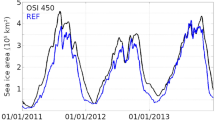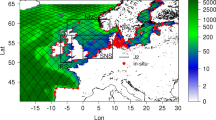Abstract
Large freshwater fluxes into the Bay of Bengal by rainfall and river discharges result in strong salinity fronts in the bay. In this study, a high-resolution coupled atmosphere-ocean-wave model with comprehensive physics is used to model the weather, ocean circulation, and wave field in the Bay of Bengal. Our objective is to explore the submesoscale activity that occurs in a realistic coupled model that resolves mesoscales and allows part of the submesoscale field. Horizontal resolution in the atmosphere varies from 2 to 6 km and is 13 km for surface waves, while the ocean model is submesoscale permitting with resolutions as high as 1.5 km and a vertical resolution of 0.5 m in the upper 10 m. In this paper, three different cases of oceanic submesoscale features are discussed. In the first case, heavy rainfall and intense downdrafts produced by atmospheric convection are found to force submesoscale currents, temperature, and salinity anomalies in the oceanic mixed layer and impact the mesoscale flow. In a second case, strong solitary-like waves are generated by semidiurnal tides in the Andaman Sea and interact with mesoscale flows and fronts and affect submesoscale features generated along fronts. A third source of submesoscale variability is found further north in the Bay of Bengal where river outflows help maintain strong salinity gradients throughout the year. For that case, a comparison with satellite observations of sea surface height anomalies, sea surface temperature, and chlorophyll shows that the model captures the observed mesoscale eddy features of the flow field, but in addition, submesoscale upwelling and downwelling patterns associated with ageostrophic secondary circulations along density fronts are also captured by the model.




















Similar content being viewed by others
References
Barron CN, Birol Kara A, Martin PJ, Rhodes RC, Smedstad LF (2006) Formulation, implementation and examination of vertical coordinate choices in the Global Navy Coastal Ocean Model (NCOM). Ocean Model 11(3–4):347–375. https://doi.org/10.1016/j.ocemod.2005.01.004
Barron CN, Smedstad LF (2002) Global river inflow within the Navy Coastal Ocean Model. Proceedings of the oceans 2002 MTS/IEEE meeting, 29–31 October 2002
Blumberg AF, Mellor GL (1987) A description of a three-dimensional coastal ocean circulation model. In: Heaps N (ed) Three-dimensional coastal ocean models. American Geophysical Union, New York, pp 347–375. https://doi.org/10.1029/CO004p0001
Booij N, Holthuijsen LH (1987) Propagation of ocean waves in discrete spectral wave models. J Comp Phys 68(2):307–326. https://doi.org/10.1016/0021-9991(87)90060-X
Calil PHR, Richards KJ (2010) Transient upwelling hot spots in the oligotrophic North Pacific. J Geophys Res 115(C2):C02003. https://doi.org/10.1029/2009JC005360
Cavaleri L, Malanotte-Rizzoli P (1981) Wind wave prediction in shallow water: theory and applications. J Geophys Res 86(C11):10961–10973
Chelton DB, Schlax MG, Freilich MH, Milliff RF (2004) Satellite radar measurements reveal short-scale features in the wind stress field over the world ocean. Science 303(5660):978–983. https://doi.org/10.1126/science.1091901
Chen S, Cummings J, Doyle J, Hodur R, Holt T, Liou C-S, Liu M, Mirin A, Ridout J, Schmidt J, Sugiyama G, Thompson WT (2003) COAMPS version 3 model description—general theory and equations. NRL/PU/7500—03-448, 143 pp.
D’Asaro ED, Lee C, Rainville L, Harcourt R, Thomas L (2011) Enhanced turbulence and energy dissipation at ocean fronts. Science 322(6027):318–322. https://doi.org/10.1126/science.1201515
Egbert GD, Bennett AF, Foreman MGG (1994) TOPEX/Poseidon tides estimated using a global inverse model. J Geophys Res 99(C12):24821–24852. https://doi.org/10.1029/94JC01894
Egbert GD, Erofeeva SY (2002) Efficient inverse modeling of barotropic ocean tides. J Atmos Ocean Technol 19(2):183–204. https://doi.org/10.1175/1520-0426(2002)019<0183:EIMOBO>2.0.CO;2
Chen S, Flatau M, Jensen TG, Shinoda T, Schmidt J, May P, Cummings J, Liu M, Ciesielski PE, Fairall CW, Lien R-C, Baranowski DB, Chi N-H, de Szoeke S, Edson J (2016) A study of CINDY/DYNAMO MJO suppressed phase. J Atmos Sci 72:3755–3779
Cummings JA (2005) Operational multivariate ocean data assimilation. Quart J Royal Met Soc Part C 131(613):3583–3604. https://doi.org/10.1256/qj.05.105
Goerss J, Phoebus P (1992) The navy’s operational atmospheric analysis. Weather Forecast 7(2):232–249. https://doi.org/10.1175/1520-0434(1992)007<0232:TNOAA>2.0.CO;2
Gomes H, Goes JI, Saino T (2000) Influence of physical processes and freshwater discharge on the seasonality of phytoplankton regime in the Bay of Bengal. Cont Shelf Res 20(3):313–330. https://doi.org/10.1016/S0278-4343(99)00072-2
Hodur RM (1997) The Naval Research Laboratory’s Coupled Ocean/Atmosphere Mesoscale Prediction System (COAMPS). Mon Weather Rev 125(7):1414–1430. https://doi.org/10.1175/1520-0493(1997)125<1414:TNRLSC>2.0.CO;2
Holland WR, Chow JC, Bryan FO (1998) Application of a third-order upwind scheme in the NCAR ocean model. J Clim 11(6):1487–1493. https://doi.org/10.1175/1520-0442(1998)011<1487:AOATOU>2.0.CO;2
Hoskins BJ (1982) The mathematical theory of frontogenesis. Annu Rev Fluid Mech 14(1):131–151. https://doi.org/10.1146/annurev.fl.14.010182.001023
Hu C, Lee Z, Franz BA (2012) Chlorophyll-a algorithms for oligotrophic oceans: a novel approach based on three-band reflectance difference. J Geophys Res 117(C1):C01011. https://doi.org/10.1029/2011JC007395
Jackson, C.R. (2004) An atlas of internal solitary-like waves and their properties, 2nd ed., 560 pp. Global Ocean Assoc., Alexandria, VA (Available at http://www.internalwaveatlas.com)
Jackson CR (2007) Internal wave detection using the moderate resolution imaging spectroradiometer (MODIS). J Geophys Res 112(C11):C11012. https://doi.org/10.1029/2007JC004220
Jackson CR, da Silva JCB, Jeans G (2012) The generation of nonlinear internal waves. Oceanography 25(2):108–123. https://doi.org/10.5670/oceanog.2012.46
Jensen TG (2001) Arabian Sea and Bay of Bengal exchange of salt and tracers in an ocean model. Geophys Res Lett 28(20):3967–3970. https://doi.org/10.1029/2001GL013422
Jensen TG, Campbell TJ, Allard RA, Small RJ, Smith TA (2011) Turbulent heat fluxes during an intense cold-air outbreak over the Kuroshio extension region: results from a high-resolution coupled atmosphere-ocean model. Ocean Dyn 61(5):657–674. https://doi.org/10.1007/s10236-011-0380-0
Jensen TG, Shinoda T, Chen S, Flatau M (2015) Ocean response to CINDY/DYNAMO MJOs in air-sea coupled COAMPS. J Met Soc Japan 93A(0):157–178. https://doi.org/10.2151/jmsj.2015-049
Jensen TG, Wijesekera HW, Nyadjro ES, Thoppil P, Shriver JF, Sandeep KK, Pant V (2016) Modeling salinity exchanges between the equatorial Indian Ocean and the Bay of Bengal. Oceanography 29(2):92–101
Kantha LH, Clayson CA (2004) On the effect of surface gravity waves on mixing in the oceanic layer. Ocean Model 9:101–124
Komen GJ, Hasselman S, Hasselman K (1984) On the existence of a fully developed wind-sea spectrum. J Phys Oceanogr 14(8):1271–1285. https://doi.org/10.1175/1520-0485(1984)014<1271:OTEOAF>2.0.CO;2
Langland RH, Baker NL (2004) A technical description of the NAVDAS adjoint system. NRL/MR/7530-04-8746. Naval Research Laboratory, Monterey
Lee ZP, Darecki M, Carder KL, Davis CO, Stramski D, Rhea WJ (2005) Diffuse attenuation coefficient of downwelling irradiance: an evaluation of remote sensing methods. J Geophys Res 110(C2):C02017. https://doi.org/10.1029/2004JC002573
Lee ZP, Weidemann A, Kindle J, Arnone R, Carder KL, Davis C (2007) Euphotic zone depth: its derivation and implication to ocean color remote sensing. J Geophys Res 112(C3):C03009. https://doi.org/10.1029/2006JC003802
Lévy M, Klein P, Tréguier A-M, Iovino D, Madec G, Masson S, Takahashi K (2010) Modifications of gyre circulation by sub-mesoscale physics. Ocean Model 34(1-2):1–15. https://doi.org/10.1016/j.ocemod.2010.04.001
Lévy M, Ferrari R, Franks PJS, Martin AP, Rivière P (2012) Bringing physics to life at the submesoscale. Geophys Res Lett 39:L14602. https://doi.org/10.1029/2012GL052756
Louis J-F (1979) A parametric model of vertical eddy fluxes in the atmosphere. Bound Layer Meteor 17(2):187–202. https://doi.org/10.1007/BF00117978
Lucas AJ, Nash JD, Pinkel R, MacKinnon JA, Tandon A, Mahadevan A, Omand MM, Freilich M, Sengupta D, Ravichandran M, Le Boyer A (2016) Adrift upon a salinity-stratified sea: a view of upper-ocean processes in the Bay of Bengal during the southwest monsoon. Oceanography 29(2):134–145 https://doi.org/10.5670/oceanog.2016.46
Mahadevan A, Archer D (2000) Modeling the impact of fronts and mesoscale circulation on the nutrient supply and biogeochemistry of the upper ocean. J Geophys Res 105(C1):1209–1226. https://doi.org/10.1029/1999JC900216
Mahadevan A (2006) Modeling vertical motion at ocean fronts: are nonhydrostatic effects relevant at submesoscales? Ocean Modell 14:222–240
Mahadevan A, Tandon A (2006) An analysis of mechanisms for submesoscale vertical motion at ocean fronts. Ocean Modell. 14(3-4):241–256. https://doi.org/10.1016/j.ocemod.2006.05.006
Mahadevan A, Paluszkiewicz T, Ravichandran M, Sengupta D, Tandon A (2016) Introduction to the special issue on the Bay of Bengal: from monsoons to mixing. Oceanography 29(2):14–17 https://doi.org/10.5670/oceanog.2016.34
Martin PJ (2000) Description of the Navy Coastal Ocean model version 1.0. NRL report no. NRL/FR/7322/00/9962, 45pp. [Available from NRL, Code7322, Bldg. 1009, Stennis Space Center, MS 39529-5004, USA]
Mellor GL (1991) An equation of state for numerical models of oceans and estuaries. J Atmos Ocean Technol 8(4):609–611. https://doi.org/10.1175/1520-0426(1991)008<0609:AEOSFN>2.0.CO;2
Mellor GL, Yamada T (1982) Development of a turbulence closure model for geophysical fluid problems. Rev Geophys Space Phys 20(4):851–875. https://doi.org/10.1029/RG020i004p00851
Metzger EJ, Smedstad OM, Thoppil PG, Hurlburt HE, Cummings JA, Wallcraft AJ, Zamudio L, Franklin DS, Posey PG, Phelps MW, Hogan PJ, Bub FL, DeHaan CJ (2014) US Navy operational global ocean and Arctic ice prediction systems. Oceanography 27(3):32–43 https://doi.org/10.5670/oceanog.2014.66
Rogers WE, Babanin AV, Wang DW (2012) Observation-consistent input and whitecapping-dissipation in a model for wind-generated surface waves: description and simple calculations. J Atmos Ocean Tech 29(1):329–1346
Sarkar S, Pham HT, Ramachandran S, Nash JD, Tandon A, Buckley J, Lotliker AA, Omand MM (2016) The interplay between submesoscale instabilities and turbulence in the surface layer of the Bay of Bengal. Oceanography 29(2):146–157 https://doi.org/10.5670/oceanog.2016.47
Schott FA, McCreary JP (2001) The monsoon circulation of the Indian ocean. Prog Oceanogr 51(1):1–123. https://doi.org/10.1016/S0079-6611(01)00083-0
Schott FA, Xie SP, McCreary JP (2009) Indian Ocean circulation and climate variability. Rev Geophys 47(1):RG1002, https://doi.org/10.1029/2007RG000245
Sengupta D, Bharath Raj GN, Shenoi SSC (2006) Surface freshwater from Bay of Bengal runoff and Indonesian throughflow to the tropical Indian Ocean. Geophys Res Lett 33(22):L22609, https://doi.org/10.1029/2006GL027573
Shetye SR, Gouveia AD, Shenoi SSC, Sundar D, Michael GS, Nampoothiri G (1993) The western boundary current of the seasonal subtropical gyre in the Bay of Bengal. J Geophys Res 98(C1):945–954. https://doi.org/10.1029/92JC02070
Shinoda T, Jensen TG, Flatau M, Chen S (2013) Surface wind and upper ocean variability associated with the Madden-Julian oscillation simulated by the Coupled Ocean-Atmosphere Mesoscale Prediction System (COAMPS). Mon Wea Rev 141:2290–2307
Shulman I, Penta B, Richman J, Jacobs G, Anderson S, Sakalaukus P (2015) Impact of submesoscale processes on dynamics of phytoplankton filaments. J Geophys Res Oceans 120(3):2050–2062. https://doi.org/10.1002/2014JC010326
Smyth WD, Hebert D, Moum JN (1996a) Local ocean response to a multiphase westerly windburst. Part 1: the dynamic response. J Geophys Res 101(C10):22 495–22 512
Smyth WD, Hebert D, Moum JN (1996b) Local ocean response to a multiphase westerly windburst. Part 2: thermal and freshwater responses. J Geophys Res 101(C10):22 513–22 533
Thomas L, Tandon A, Mahadevan A (2008) Submesoscale processes and dynamics. In: Hecht M, Hasumi H (eds) Ocean modeling in an eddying regime, Geophys. Monogr. Ser, vol 177. AGU, Washington, D. C, pp 17–38. https://doi.org/10.1029/177GM04
Wijesekera HW, Gregg MC (1996) Surface layer response to weak winds, westerly bursts, and rain squalls in the western Pacific Warm Pool. J Geophys Res 101(C1):977–997. https://doi.org/10.1029/95JC02553
Wijesekera HW, Paulson CA, Huyer A (1999) The effect of rainfall on the surface layer during a westerly wind burst in the western equatorial Pacific. J Phys Oceanogr 29(4):612–632. https://doi.org/10.1175/1520-0485(1999)029<0612:TEOROT>2.0.CO;2
Wijesekera HW, Paulson CA, Skyllingstad ED (2003) Modeling the evolution of a fresh sea surface anomaly produced by tropical rainfall. J Geophys Res 108(C11):3338. https://doi.org/10.1029/2002JC001408
Wijesekera HW, Jensen TG, Jarosz E, Teague WJ, Metzger EJ, Wang DW, Jinadasa SUP, Arulananthan K, Centurioni LR, Fernando HJ (2015) Southern Bay of Bengal currents and salinity intrusions during the northeast monsoon. J Geophys Res 120(10):6897–6913. https://doi.org/10.1002/2015JC010744
Acknowledgments
We would like to thank Tim Campbell at NRL Stennis Space Center for his help with COAMPS and Jan Dastugue for the help with the graphics.
Funding
This work was supported by the US Naval Research Laboratory (NRL) 6.1 Core Program “Effects of Bay of Bengal Freshwater Flux on Indian Ocean Monsoon (EBOB)” and by the US Office of Naval Research (ONR) in an ONR Departmental Research Initiative: Air-Sea Interactions Regional Initiative (ASIRI).
Author information
Authors and Affiliations
Corresponding author
Additional information
Responsible Editor: Ananda Pascual
This article is part of the Topical Collection on the 48th International Liège Colloquium on Ocean Dynamics, Liège, Belgium, 23-27 May 2016
Rights and permissions
About this article
Cite this article
Jensen, T.G., Shulman, I., Wijesekera, H.W. et al. Submesoscale features and their interaction with fronts and internal tides in a high-resolution coupled atmosphere-ocean-wave model of the Bay of Bengal. Ocean Dynamics 68, 391–410 (2018). https://doi.org/10.1007/s10236-018-1136-x
Received:
Accepted:
Published:
Issue Date:
DOI: https://doi.org/10.1007/s10236-018-1136-x




